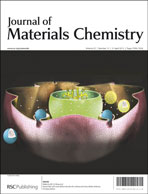In this study, we report controlled fabrication of flower-like ZnO–Fe2O3 nanostructured films on copper foils and their excellent lithium storage properties. The films were fabricated through a method called “partly sacrificed template”, which involved immersing ZnO nanorod arrays in 0.1 M aqueous solution of ferrous sulfate and subsequent calcinations at 350 °C. The ZnO template was partly dissolved by the acid produced from the hydrolysis of FeSO4 precursor and then initiated the construction of the flower-like architecture. The resulting ZnO–Fe2O3 nanostructured films not only showed a great different architecture from that of the original template, but also exhibited a high reversible capacity of 776 mAh g−1 (up to 50 cycles), excellent cycling performance and outstanding rate capability as anodes for lithium ion batteries. The mechanism responsible for the excellent electrochemical performance arises from the good electronic conduction, physical buffering effect, and high porosity of the flower-like architecture. The finding of this study presents an alternative approach for constructing nanostructures on metal substrates that might be applied for energy-storage devices and sensors.

You have access to this article
 Please wait while we load your content...
Something went wrong. Try again?
Please wait while we load your content...
Something went wrong. Try again?


 Please wait while we load your content...
Please wait while we load your content...